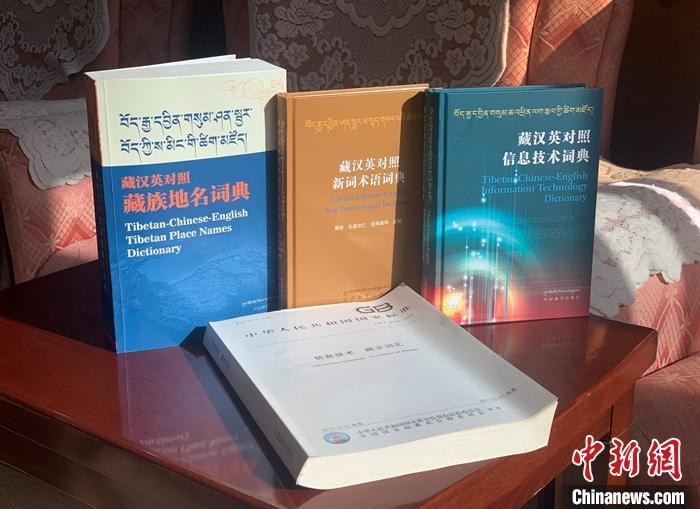China News Agency, Beijing, December 22. Question: "WeChat" or "Gecheng"? Tibetan Scholars Discuss the Meaning of Standardization of Tibetan Terminology
Author Li Hanxue Yang Chengchen
When entering Tibet along National Highway 318, tourists often have doubts about the names of Tibetan people: from Kangding to Lhasa, names written in the same Tibetan language have "two faces" when translated into Chinese, Tsering becomes Zeren, Suolangcheng Changed Silang and Qiangba to Xiangba.

The picture shows the results of the standardization of Tibetan terminology that have been published in Beijing. Photo by China News Agency reporter Yang Chengchen
This is actually the inconvenience caused by Tibetan accents in different regions. Tourists often take it as an anecdote when they learn the truth. However, there are countless examples in the process of Tibetan-Chinese and Chinese-Tibetan translations that make people "dumbly unclear". The fields involved are broader, and the inconsistency of relevant terms not only affects social usage, but even international discourse related to Tibetan issues. right.
What few people know is that under the impetus of the Chinese Ministry of Education and the National Language Work Committee, the standardization of Tibetan terminology has been continuously carried out in the past few decades. Recently, Tashi Tsering, a researcher at the library of the China Tibetology Research Center who has participated in it for a long time, accepted an exclusive interview with a reporter from China News Agency.
The National Tibetan Terminology Standardization Working Committee was established in 1995. Since 2011, the China Center for Tibetan Studies has taken the lead in coordinating the standardization of Tibetan terminology across the country. Every year, the committee solicits annual high-frequency new terminology from Beijing, Tibet and the Office of the Language Committee of the four provinces and districts related to Tibet, news media, universities and other institutions, and then holds an expert review meeting, and then publishes the approved new words in the form of documents and bulletins. Terminology released to the community.

The picture shows Tashi Tsering being interviewed in Beijing. Photo by China News Agency reporter Yang Chengchen
According to Tashi Tsering, when a new word is translated from the national standard language into Tibetan, there may be multiple translation methods: transliteration based on Chinese pronunciation, free translation based on different ideas, and even transliteration based on foreign language pronunciation. On the one hand, this leads to confusion and lack of seriousness in the use of words, and less rigorous translations may also cause misunderstandings.
He gave an example, "Chinese Dream" refers to the lofty ideal of the Chinese people to realize national rejuvenation; "dream" in Tibetan does not have the meaning of "ideal", and it is obviously inappropriate to translate it literally. Therefore, new Tibetan terminology must be regulated in a timely manner.
After the outbreak of the new crown pneumonia epidemic at the beginning of this year, the committee issued a Chinese-Tibetan communiqué for epidemic-related terms such as "new crown pneumonia" and "human-to-human transmission" at the end of February, thereby ensuring that information related to the epidemic was accurately conveyed in the Tibetan context.
In addition, in science and technology, place names, law, economics and finance, and even English for postgraduate entrance examinations, the results of Tibetan terminology standardization work have been published in recent years. Tashi Tsering said that Tibetan-Chinese-English dictionaries in various disciplines are very popular and have become desk reference books for many Tibetan scholars.
Tashi Tsering opened the "Tibetan-Chinese-English Information Technology Dictionary" published in 2007 for the reporter, which is one of the important tasks in recent years. He lamented that, in fact, many Tibetan terminology standardization work had to be "competitive" with others, because overseas academic institutions were also carrying out similar projects. Taking computer coding as an example, “If China hadn’t completed the formulation of an international standard for Tibetan coding, research institutes in other countries might propose another set of coding and apply for international standards using the Tibetan alphabet.”
"If a single letter is missed, wouldn't it harm our interests?" Tashi Tsering said that the place with the largest population of Tibetan speakers is China, "this standard should of course be formulated by us." Therefore, the standardization of Tibetan terminology is related to the issue of Tibetan discourse power.
There was a time when the Tibetan name of WeChat did not have a corresponding Tibetan translation, so many users used to call it by the English name "WeChat". A few years ago, the National Working Committee for the Standardization of Tibetan Terminology approved the free translation of "Gecheng", which means "sound transmission" in Tibetan. With the dissemination and promotion of various media and dictionary apps, "Gecheng" has now become the Tibetan "big name" of WeChat in daily use. In many overseas Tibetan communities, this name is also mainstream.
In order to keep up with social changes and complete the translation, experts and scholars represented by Tashi Tsering have made continuous efforts for many years. After the publication of the Information Technology Dictionary, after soliciting opinions, revisions and additions, it finally led to the release of the national standard "Tibetan Vocabulary for Information Technology" in 2017. The "Tibetan-Chinese-English Dictionary of New Words and Terminology" published in 2015 will be revised in early 2021, adding more than 1,000 new words.
"The emergence of new words is also a manifestation of social progress." Tashi Tsering said that because of the active society and frequent exchanges between people from all over the world, new words continue to emerge. The demand for constant renewal of Tibetan language standardization work is also a manifestation of social progress in Tibet and Tibet-related provinces and regions. (over)
Source: China News Network
Articles are uploaded by users and are for non-commercial browsing only. Posted by: Lomu, please indicate the source: https://www.daogebangong.com/en/articles/detail/WeChat%20or%20Gecheng%20Tibetan%20Scholars%20Discuss%20the%20Meaning%20of%20Tibetan%20Terminology%20Standardization.html

 支付宝扫一扫
支付宝扫一扫 
评论列表(196条)
测试